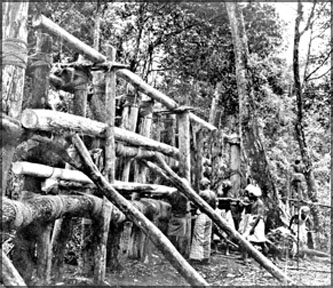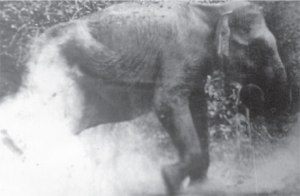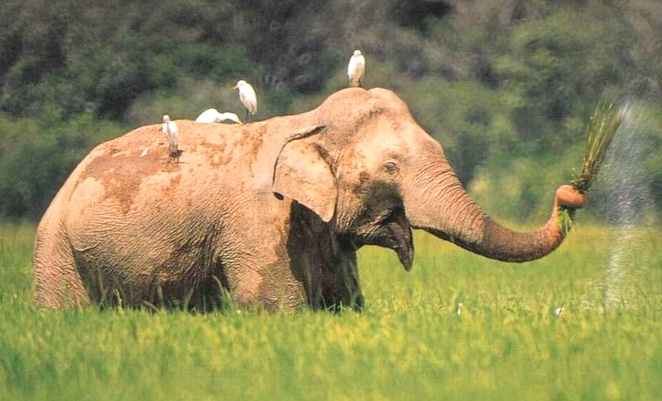Although Sri Lanka’s last Kraal was held nearly 60 years ago at Panamure under patronage of Francis Molamure, the legend that surrounds the happenings of the last Kraal gets refreshed with every new generation.
Today it is synonymous with a bull elephant of magnificent size, ‘who laid its life to protect the rest of the 16 elephants in the herd’. The shooting of the elephant led to a public up rise and a red hot debate in the parliament, which ultimately ended with the banning of elephant kraals in the country.
Capturing of wild elephants for trade, industry and cultural purposes had been an intricate part of the Sri Lankan history for the last 2000 years. The Mahavansa, historical chronicles of Sri Lanka records exporting tuskers and elephants to country as far as Rome and Greece through Muslim traders, a trade which was later adopted by the country’s colonial masters.
The early forms of capturing elephants were the use of noose and a tame elephant while the use of Kraal or a stockade built with strong timber was a novel form introduced during the 13-14 th Century by South Indians. The Kraal is triangular in shape with a wide entrance and an ending in a funnel or narrow passage. Inside were two timber enclosures, big enough to accommodate the elephants that are driven in as a group. Once inside the enclosures the elephants were captured, tamed and trained for many an occasions including carrying heavy loads to participating in flamboyant cultural festivals.
Panamure, a Kraal situated within the 99,000 acre forest land owned by Sir Francis Molamure had been a flourishing Kraal town since 1896, equipped with its own post office and police station and many businesses to accommodate the Kraal builder, elephant handlers, log cutters and many service men gathered to maintain this mammoth Kraal of 200 acres. It was built surrounding a perennial spring, which attracted many herds of elephants in the area and was proven to be a very successful kraal until the year of 1950.
The participant of the 1950 Kraal included the top blue bloods of Sri Lanka including the governor general and the event was turning out to be an average rounding of elephants until the selected herd was led to the stockade by the beaters. The herd was made up of 16 elephants with few loners hanging around. Two of the females were in estrus and unfortunately one strong young bull had run into the stockade with the herd.
The event took a violent twist when the matriarch of the herd was noosed and toed to a tree. The bull, who was mating the matriarch inside the stockade reacted to the noosing of his lady love violently, attacking the tame elephant assisting the ‘noosers’. He had twice broken the one inch thick wire rope used for noosing and had scared the daylight out of many tame tuskers, who were sent to control the violent visitor.
 After ruling out the option of releasing the maddened bull on the possibility of endangering Kraal participants and villagers the organizers of the Kraal were forced to shoot the tusker, leading to countrywide rise of emotions and commotions and a ban on Kraals and killing of elephants.
After ruling out the option of releasing the maddened bull on the possibility of endangering Kraal participants and villagers the organizers of the Kraal were forced to shoot the tusker, leading to countrywide rise of emotions and commotions and a ban on Kraals and killing of elephants.
Panamure is but a memory now. Gone are the elephants that roamed free in these jungles and the jungle itself. Just one or two of the upright post of the stockade are left and preserved in this town as historical mementos and they stand in mute testimony of an event that changed the fate of Sri Lankan elephants sixty years ago.


Intersting information. Is there any records as to where the elephants went, after training?
LikeLike
They were sold on auction for domestication
LikeLike
Is there any possibility to find out where they went? Heres a list I made on my website with elephants transfered 1950, one which you can easily find on that list with the name Komali is a documented Sri Lankan elephant, she died in Dublin Zoo 1966, after arrival from Dehivela 28th June 1950 >> http://www.elephant.se/database2.php?elephant_id=1023. A second elephant, Vally, (who died 1974 in Whipsnade Wild Animal Park) is also claimed to have been shipped out from Colombo in July 1950 http://www.elephant.se/database2.php?elephant_id=2146, possibly more from this may have origin from Sri Lanka. From the transfers in 1951, which may be more likely, if some of the elephants needed more time for training before being transfered, at least the following were cought on Sri Lanka: Baby Nona, (claimed to come from from Galowya area) who died in Pinnawela (dont know when??) >> http://www.elephant.se/database2.php?elephant_id=6129
LikeLike
I did some research and realized that maybe the animals shipped in 1950/51 were not captured at the Panamure Kraal, but through individual license issued to estate owners or large scale farmers to kill or trap animals that are damaging their crops. Quite a large number of elephants had been captured and tamed through this process even after the banning of Kraals. As you have noted the elephant captured in Gal-Oya would have been captured by individuals as Panamure is in Rathnapura and not near Galoya.
LikeLike
Why do you say this incident changed the fate of Sri lankan elephants? Since there’s no kraal. There’s no jungle left too. If the kraal was there. May be the jungles would have survived..
LikeLike
Well, If not for the outcry of the general populace Kraals would have continued for at least another two decades until the public land declaration in ’70 s. Kraals did not kept the jungles alive and the jungle did not disappear due to lack of Kraals. The Kraals were inhuman and was a toil on elephant population and the jungles are vanishing due to over population and spread of agriculture and development and bad forest management.
LikeLike
I just read the abbreviated description/ account of the last Kraal. One point of clarification. The magnificent bull elephant was not a tusker. For some reason, there is a myth that it was an “Atha”.
Photographic evidence is to the contrary.
LikeLike
Thank you Arjuna for the feedback
LikeLike
Who was the crack shot who took the bull with one bullet facing him in mid charge ??
LikeLike
I beliver it was Sam Kadirgama,
LikeLike